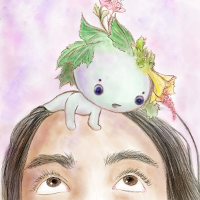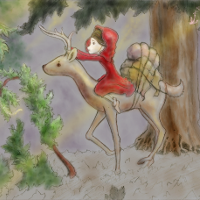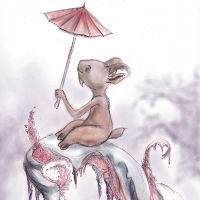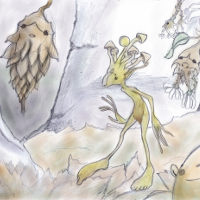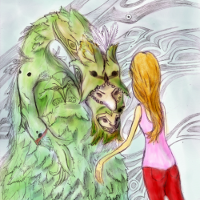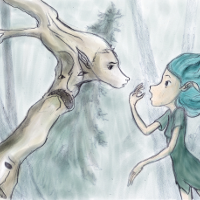 |
Information and stories on Japanese Gods
.
 |
|
Kami Fairy Tales Home Fairies Celtic Fairies Fairy Blog Finno-Baltic-Siberian Fairies Slavic Fairies
|
Japanese Fairy tales Oni Tengu Kitsune Tanuki  More Folk Beliefs Folk Religions are based on the idea of building a relationship with the spirit world, and are understood through folk tales and so often much stranger than more structured religions. With that in mind it's important to keep in mind that Shintoism and folk religion in Japan aren't always one and the same. A man in Tono had a beautiful daughter who married a horse, and she would sneak out to the stable to be with him. When the father learned of this he was furious and he had the horse killed and hung from a mulberry tree. His daughter went out the tree and climbed onto the horses head. Disgusted the man cut off the horses head and the girl and the head flew off into the sky. She then became a kami named Oshira-sama who is now a kami of agriculture and silkworms. (Silk worm production was done in mulberry trees.) Love has a certain amount of power to cause both good and bad. A young girl from a wealthy family fell in love with a temple page while out cherry blossom viewing. She sickened and pined for the young man, in order to comfort her, her mother bought a long-sleeved robe of the same pattern the page had worn; but though the daughter kept it by her and would not let it out of her sight, she grew no better and eventually died. The family offered the clothing they’d given her to the temple, and ayoung girl bought it a few months later; soon after she pined away and died as well. Again the dress was donated back to the temple and the priests sold it, again the girl who purchased it pined away and died. By this time the priests were very properly frightened, and they made up a bonfire and threw in the unlucky robe, when, to their horror, a gust of wind caught the thing and bore it, all flaming, against the side of the temple. The whole street caught, the fire leaped over the river and burned its way all across the city, going out only when there was nothing more to burn. Two more fires, within a couple of days after, destroyed the palace and miles of houses; the prison gates were opened, but a warder closed one of the city gates against the prisoners and cut off not only these, but hundreds of citizens, who were caught by the fire or trampled to death. There were so many unclaimed bodies that a special burying ground was made for them on the far side of the river, and a memorial temple built, where masses were said for these unknown dead; hence its name, Ekoin, temple of mass-reading. It's important to understand that in folk religion all things, whether they be people, animals or even objects have their own power, their own life/soul. Everything in Japanese folk religion is about building and maintaining relationships with everything else. Everything in folk religion also has a power of its own, even if its not always aware of it. So before peeing a person should warn the worms of the ground to move out of the way. If a person pees on a worm than the worms anger and bad feelings will cause the persons penis to swell painfully. Similarly when a fire killed a cow in one village the cows owner built a shrine made of clay tiles to the animals spirit. As people prayed to the cow kami they found that it had the power to cure skin diseases. Soon word got out about this and so people began to travel to pray to the cow kami, bringing with them offerings of grass tied in small bundles. Because rice planting is long boring work and the kami had to be kept there to help, women would humor the kami by wearing only a loin cloth so that he could see their lower anatomy as they worked. The women would also tell dirty jokes and stories. Rice planting songs were also often about sex as there is a relationship between human reproduction and the fertility of the land. Kami lived not only in nature and shrines but also in statues of them. For the Rain and Wind Festival in the Tono district people will make straw figures with paper faces and male and female parts made from melons. They bring these figures in procession to the crossroads where they play music and have a feast for them. Okunai-sama is the Kami of a household which is carved from mulberry wood with a simple face drawn on it. A piece of cloth with a hole in it is put over this to act as a piece of clothing. In one story the Okunai-sama comes into the fields as a short boy and helps to plant the rice fields before a storm comes. No one realizes the helpful boy is Okuanai-sama until they return home and find that the statue is covered in mud from the fields. Another kami of the household is Kamadogami. This deity is often characterized within a mask of a distorted face which is hung near the heart. Kamadogami is a spirit not only of the household but he also contains elements relating to agriculture, children, and similar activities. Chimata-no-kami is the Kami of the roads, paths, and crossroads. He is represented by a phallus. He also helps women gain fertility and men with erectile dysfunction problems. There are many spirits which are helpful to humans. Zashikiwarashi for example appear as twelve or thirteen year olds and can be male or female, though they typically remain hidden. They bring good luck to a household and should they leave misfortune will fall. Once a man saw a pair of girls leaving the house of a wealthy man. The girls said they were going to another farm and soon afterwards nearly everyone in the house they’d left died without the luck they brought. In another tale a fishermen took a boy across the shore who said he was moving out of a wealthy household because they were rebuilding it. The boy wanted to move to live in an old house. Soon after the wealthy house the boy was leaving ran into bad luck and the one he’d moved into prospered. A new governor to a regon went around to greet and pay respects to all the kami of the region when he came upon a ruined shrine in some woods. When he enquired about this he was told that a fight between the monks of the shrine had caused it to loose its government funding. Feeling bad for the kami within it the governor ordered the shrine to be restored, he also promised to pay his respects to the kami as people had once done. The kami in gratidude helped the governor become the governor of Hitachi when his post was done in the region of the kami. A lord wanted a good post in the court so he sent for a wonder worker to help him get it through the use of magic. The Monk assured the lord that he could help the lord get the post he desired through the use of Dakini rite which utilizes fox magic. During the second rite a fox came and ate the offerings which was seen as a good sign. Later the lord had a dream in which a girl brushed her face with her long black hair as it trailed byhind her. He then awoke with a fox tail against his face. The lord got his desired post and learned the Dakini rite himself with which he performed many mircles. In addition he inshrined the fox’s tail and gave the kami the name Fukutenjin (Kami of good fortune). The dead spirits of people which live in the mountain valleys and caverns, or which wonder the earth are helpful so long as they are given respect - acting as beneficial guardian spirits. Spirits which people don’t worship, those with no decendants, aborted fetuses, etc will often become harmful and dangerous. Hidarugami for example is the ghost of someone who died alone in the moors or mountains. This ghost possesses people making them so hungry they faint. To restore them a person must be given mochi. There are also many other beings. In Yamaguchi village a man saw a women come out of the bamboo grass and walk towards him. She had long black hair which trailed behind her, and a baby strapped to her back with wisteria vines. Her kimono was of common striped cloth and was starting to ware away so was patched with leaves. Her feet didn’t seem to touch the ground. She passed him by and soon he grew ill for a long time. Girls are at times abducted by ordinary looking men with red eyes. The men then carry the girls off to live with them in the mountains often having children with the women. A man who worked for a wealthy choja dove down into a deep pol and found a house in the shadows of the rocks. Inside was the daughter of his master who’d drowned weaving at a loom. She made him promise to tell no one he’d seen her. When he did she made him wealthy by granting him such luck that he almost never lost at gambling. However he eventually told the story and so his luck ended such that he soon lost everything. Some people saw a woman crouching beside a river smiling repeatedly. Eventually a rumor spread that someone was visiting the woman at night. Eventually people realized that this was a kappa so her relatives gathered to protect her, but this failed. Soon the woman was pregnant, and in order for her to give birth they had to put her in a tub of water. The woman then gave birth to a part kappa. Some people said this had occurred in her family before and was the reason her family was wealthy and had an the surname of those who had been part of the warrior-class. Sometimes mayoi-ga or a magical house appears to someone in the wilderness when they get lost in order to help the person. The person is then able to take anything from the house they wish. One woman not realizing what she’d found left the house alone and so a magical bowl with which she could scoop an unlimited amount of rice floated down the river too her. Among the Ainu there is a female vampire named Kenash Unarabe, often takes the form of the deity of the hunt so that she can lure humans to her inorder to drain their blood. Despite this she is also invoked during rituals for those givng birth to come and remove the pollution in return for the blood flowing from the woman. |
|
